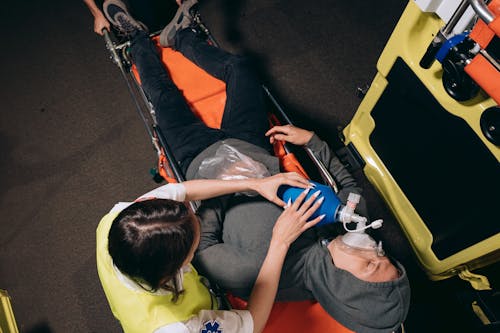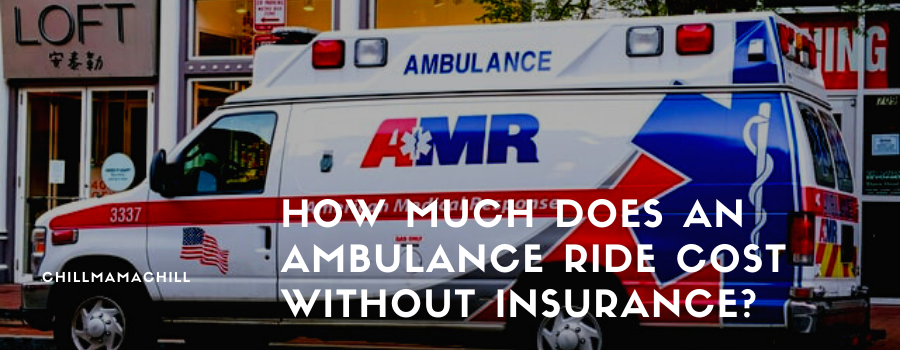If you’re involved in an accident or a car crash, they’ll take you to a hospital by ambulance. While your first consideration is your wellbeing, you’ll also want to know at what price the ride costs. It’s more worrisome if you’re uninsured, and the question on your mind will be, ‘how much does an ambulance ride cost without insurance?
Prompt medical attention, including rapid response paramedic care, saves lives. But ambulance rides aren’t cheap, a fact that’s exacerbated by a lack of health insurance or other inclusive coverage.
Costs depend on the service provider, miles to the hospital, and why you’ve had to ride in one. On average, an ambulance ride costs between $350 and $2500 for an ambulance ride trip when you aren’t insured.
Ambulance services are expensive because you aren’t only paying for your transportation and the professional emergency medical stabilization, and the availability of rides in that area. More than 70% of providers don’t consider health policies, so many people try to avoid them when they can. This article explores causes for steep ambulance rides and how that works out if you have no insurance.
Who Runs Ambulance Services, and Why Are They So Expensive for the Uninsured?
At one time, a patient received a bill for $3,600 for a four-mile ambulance ride. Another had to be transferred from a hospital that couldn’t handle her case to another with facilities for $8,500. Yet another unaware accident victim found himself marooned at a hospital outside his insurance coverage network, having been driven there while unconscious.
Ambulance rides often take place in emergencies, and then you’ll get slammed with an unexpected, excessively exorbitant bill. Usually, the situation is out of your control once you, the police, or someone else dial 911. The dispatcher picks the ride company, which in turn chooses which hospital they’ll take you to.
Sometimes it’s the hospital, fire department, or a firm hired by the municipality which turns up. Ambulances are public entities like the public health department or fire services, but you won’t distinguish between private and government-owned rides. Many municipalities use them as the cash cows that finance other emergency services.
It’s the bill you’ll receive afterward which threatens to keep you in the hospital longer, of a heart attack. Whether the ambulance is publicly owned, for-profit, or non-profit, they’ll send you a bill steeper if you aren’t covered by insurance. On average, across the country, even insured patients pay an excess of $450. That’s from the 30% of ambulance companies that accept coverage.
Why Am I Charged So Much for an Ambulance Ride without Insurance?
According to one Emergency Medical Technician or EMT, ambulance rides cost as much as they do due largely non-regulated pricing. These operating entities are neither public nor private. There’s also the issue of collections. That’s because the collection rate currently stands at about 10% of all the bills charged. That means for every bill paid in full, Medicaid caters for two while the rest are uncollected.
It’s an issue faced by healthcare in general and not unique to ambulances. Unless these operators raise charges, they can’t meet operating costs, as Medicare and Medicaid fees are federally set. Only commercial health insurers ever pay the entire bill, and the best these companies or municipalities can hope to get is 24% of their total billing.

The contractual network of hospitals where this coverage is accepted further complicates ambulance rides costs left unarticulated. Furthermore, emergency medical personnel are highly trained and, in turn, must earn well. You wouldn’t like it if a minimum-wage earning paramedic crew was responding to your emergency, especially the medics that save lives.
These professionals make up about 61% of an ambulance’s operating costs. Add that to fuel, facility rentals, maintenance, administrative, and operating costs, and you have an expensive-to-run entity. Ambulances aren’t always running for calls, which amount to at least once every three hours in a busy city, less in rural settings. That decreases efficiency, calculated using a Unit Hour Utilization or UHU factor as a batting average, while their bills remain paid.
How Can I Protect Myself from Costly Ambulance Rides without Insurance?
During my research, I found out that insurance only pays for the ride when accepted by the ambulance operator. If you were choking by the roadside and a paramedic doctor performs a lifesaving Heimlich maneuver, they don’t get paid unless they’ve taken you to a hospital. That’s despite ambulances being medically equipped vehicles that will sustain your life until you’ve reached a medical center.
An ambulance contains stretchers, spine boards, oxygen ventilators, defibrillators, IV fluids, bandages, pills, patches, and much more. In some licensed ambulances, you’ll find medical personnel trained to perform surgery or administer anesthesia if you’re critically injured. These paramedics deal with all manner of accident victims, overdoses, heart attacks, spinal injuries, strokes, suicide attempts, and broken bones.
If you’re uninsured, expect to pay hundreds if not thousands of dollars out of pocket. Different states have varying billing rates for an ambulance ride, and your bill can increase exponentially. But some options can find you paying lower costs, or you can take advantage of several federal and state incentives. If all that fails and you’re in a position to refuse an ambulance ride. You can take a taxi or an Uber to the hospital instead.
In New York City, the cost for a 2-mile ambulance transport service with essential life support is $726 on average. That’s equivalent to 50 rideshare rides, with one Uber ride for the same distance costing $15. If your medical situation isn’t an emergency, requiring stabilization along the way, a taxi ride gets you there, albeit in more time.
Do Ambulance Costs Get Cheaper When I Have Insurance?
Many insurance providers in the US provide cover for ambulance rides as part of their medical emergency coverage on policies. Often that includes transport to the nearest network plan hospital and any services offered by the paramedic crew. That’s if the costs get covered, but when they’re charging more than your payout limit, the provider or EMT Company sends you a co-pay or balance bill.

If you have health insurance, for instance, you may end up paying between $50 and $150 out of pocket. According to regulators, a patient with a commercial policy can expect to pay an average of $432 for an ambulance ride. On the other hand, if you’re uninsured, you can expect a typical bill of between $400 and $1500, or even more.
In some cities, non-emergency essential life support costs $375, while emergency services with advanced life support will be charged up to $600. There are places with membership plans for uninsured ambulance rides, such as in Nichols Hills, Oklahoma. However, nonmembers of this program pay $1,000 and $9 per mile in addition to rides.
Besides basic ambulance ride charges, other types of costs make it expensive when you have no insurance. During your drive to the hospital, you may need medical supplies. That’s true, even before they strap you to a stretcher at the scene of an accident or emergency. Items like sterile gloves, IV systems, catheters, bandages, and such can add hundreds if not thousands of dollars to your bill.
On average, you’ll pay between $20 and $35 for bandages, oxygen masks, ice packs, and dressings. You’ll also be charged $40 and $65 for obstetrical or burn kits. Expect to part with a range of $70 to $95 for a pulse oximeter or an infusion pump. Any therapist, nurse, or respiratory specialist you’ll need during your ambulance ride costs you an additional one hundred dollars.
Can I Dispute a Hefty Ambulance Bill or Refuse Their Services If I Am Uninsured?
It costs nothing to call an ambulance, and the same applies if the paramedics arrive and don’t take you to the hospital. However, it depends on the company providing services, as others will charge when called to a scene without transport or emergency medical services.
When you’ve got health, accident, or other coverage that provides for emergency services, you’ll forward the bill you receive to your insurer after looking it over and signing it. Alternatively, you can return it to the ambulance provider, who’ll then pass it on to your carrier. Any balances or due remaining after payment will then be billed to you in a revised bill for payment.
If you don’t receive a bill from the ambulance operator, it could be that your insurance has covered it. When you have no insurance, you’ll be expected to foot the entire cost. You can dispute high charges, especially for unreasonably high bills. You can scan it for flaws that include duplicate charges, inaccurate mileage, or incorrect service dates.
On finding errors, contact the ambulance company immediately or their billing department. It’s within your right to deny ambulance service, especially if you’re uninsured. That’s as long as you’re an adult, coherent, and conscious of the time the paramedics arrive. You can choose alternative transport to the hospital, saving yourself a hefty transport or emergency service bill.
Conclusion
Ambulances and the paramedics who work in them are modern-day heroic machines. But that is undermined by the high costs of emergency medical care and transport to hospitals, especially for the uninsured. Having answered the question ‘how much does an ambulance ride cost without insurance, you’re now empowered to look for alternatives or buy coverage to reduce out-of-pocket payments.

